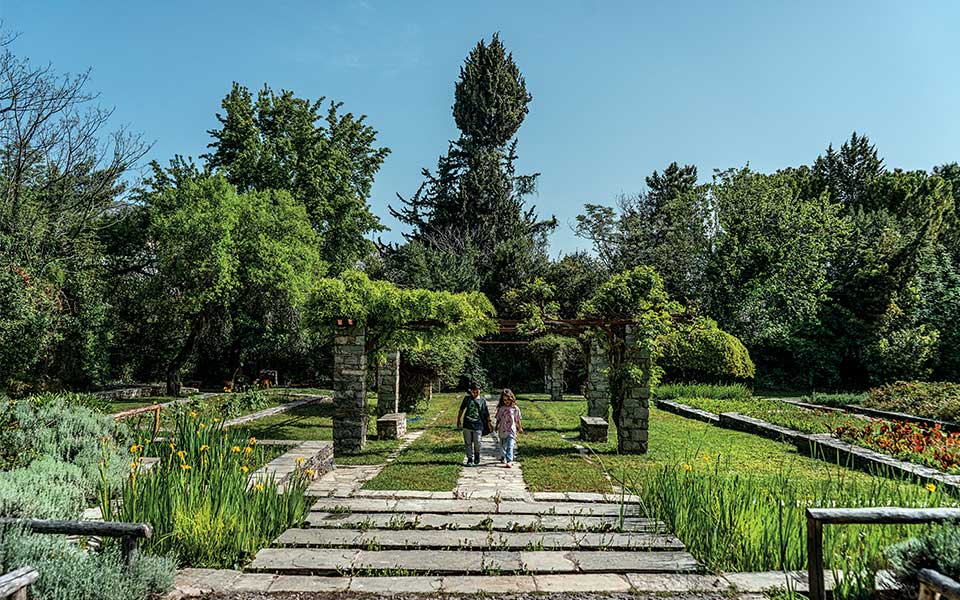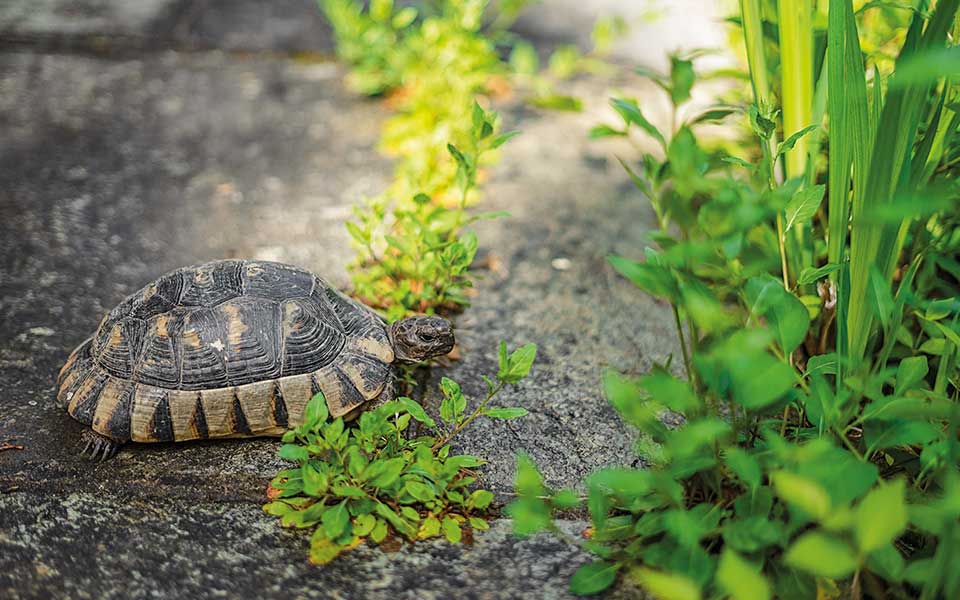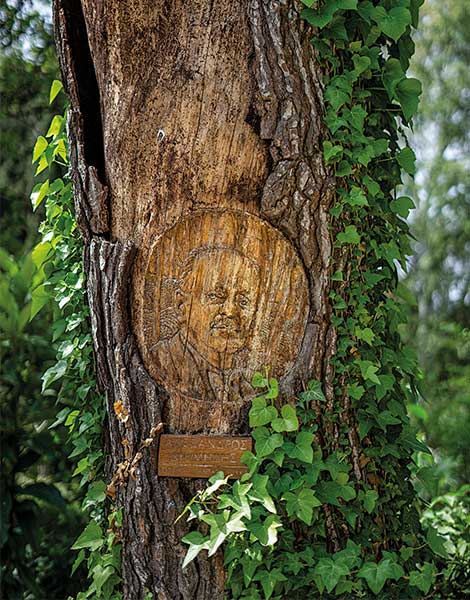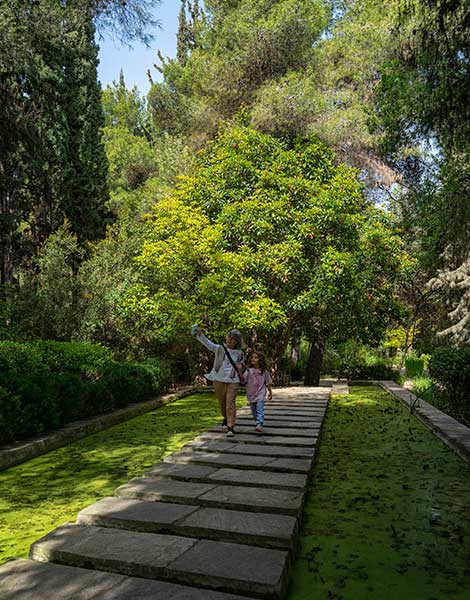Don Dines in Athens: Tzimis, Vyronas
Beyond souvlaki lies a carnivore’s paradise,...

The Julia and Alexander N. Diomedes Botanical Garden has a long history and an important ecological mission.
© Marika Tsouderou
In these final weeks of spring, the Julia and Alexander N. Diomedes Botanical Garden, resembles a fireworks display; hundreds of flowers of different colors and shapes, blooming against a backdrop of tall trees and dense shrubs, are on view for those groups of visitors expected towards the end of May. Those interested will need to make a reservation online, and numbers will be limited to 600 daily.
The garden is located in the neighborhood of Haïdari, at 403 Iera Odos, and stretches over 200 hectares, making it the largest botanical garden in the eastern Mediterranean. It was created according to the wishes of the economist and lawyer Alexander N. Diomedes, head of the National Bank of Greece, first governor of the Bank of Greece, and a close advisor of Eleftherios Venizelos.
Upon his death in 1950, this part of his estate was bequeathed to the University of Athens with instructions to create the garden. Its design was overseen by Herta Hammerbacher, Professor of Landscape Architecture at TU Berlin, and work on it was completed in 1975.

The forested area composes a rich ecosystem that’s home to 600 species of local flora, including the Greek tortoise, commonly known as the spur-thighed tortoise.
© Marika Tsouderou
Once they’ve entered through the garden’s stone gateway, visitors will have the opportunity to see more than 4,000 local and imported plant varieties, including plants mentioned in historical sources, decorative plants from around the world, plants with pharmaceutical properties and more. Trees and shrubs play an important part, too, creating an attractive backdrop for the constantly changing appearance of the garden, particularly from spring through fall.
For a relaxed stroll, you can follow the recommended 1.5-km route. To the left of the main entrance, the central promenade invites you to admire the grounds, with hidden recesses slowly revealed on either side, as well as the network of 25 ponds that introduce the element of water to the garden.
The walk begins with a feature which is unique among botanical gardens around the world: the historical section. “Here you’ll find plants mentioned in Greek mythology, in the Old and New Testaments, and in the texts of ancient authors, including such plants as hemlock (Conium maculatum), used to put the philosopher Socrates to death; giant fennel (Ferula communis), in whose stalk Prometheus concealed fire stolen from the gods; and many others,” says Stelios Soulios, financial and administrative director of the Garden.

The creation of the garden was inspired by Alexander N. Diomedes, first governor of the Bank of Greece, whose likeness is carved on this tree.
© Marika Tsouderou

A pond with stepping stones. The surface of the water is covered in bright green duckweed, a floating aquatic plant.
© Marika Tsouderou
Next comes the decorative plants section, which is the most charming part of the garden. This section, featuring paved areas, pergolas and benches for rest breaks, and verges rich in decorative plants from around the world, is an ideal spot for quiet contemplation. Its highlights include beds of dahlias (Dahliax pinnata) and irises and narcissi of different species, adding splashes of color year-round. In the west section, you’ll find mostly climbers and shrubs. There’s also a rose garden, with more than 100 different types of roses.
Following the path through the bamboo forest, you’ll come to a pond with stepping stones that will make you think you’re walking on water. With its surface covered in common duckweed (Lemna minor), a floating green aquatic plant, this body of water is as impressive as those with water lilies.
Continuing your tour, you’ll come across two more sections, both with plants of practical value to people. The first features trees whose fruit, bark or other parts hold a general commercial value. These include Quercus suber, commonly called the cork oak, whose bark is harvested for cork; the coffee tree; and a number of citrus and other fruit trees. The second section features pharmaceutical plants, some of which have been known since antiquity for their healing properties. Among them are Cretan diktamo (Origanum dictamus) and St John’s Wort (Hypericum perforatum), and many others.
On the return route, you’ll pass by the garden’s largest body of water, with a depth of around 2 meters, and home to shimmering koi carp. Back at the entrance gate, turn right and head past the café for the arboretum, featuring trees from all over the world. Among them is the sequoia, the world’s tallest variety of conifer. This forested area composes a rich ecosystem that’s home to 600 species of local flora, and birds, foxes and other animals. There’s also a children’s playground, with activity equipment made mostly from old tree trunks.
The Julia and Alexander N. Diomedes Botanical Garden also functions as a wildlife sanctuary and has designated an area for use by the charity ANIMA, to help with the reintegration of rescued wild animals into their natural environment.
The Environmental Awareness Center located in the park offers seven different educational programs for schoolchildren from around Greece. For more information, please call: (+30) 210.581.1557; (+30) 210.581.2582; or (+30) 210.581.3049. alternatively, visit the website at diomedes-bg.uoa.gr
The garden is due to open at the end of May, with the introduction of the new online reservation system.
Beyond souvlaki lies a carnivore’s paradise,...
Six Athenians tell us about their...
Souvlaki joints started appearing in earnest...
Ten must-do experiences in Athens, from...